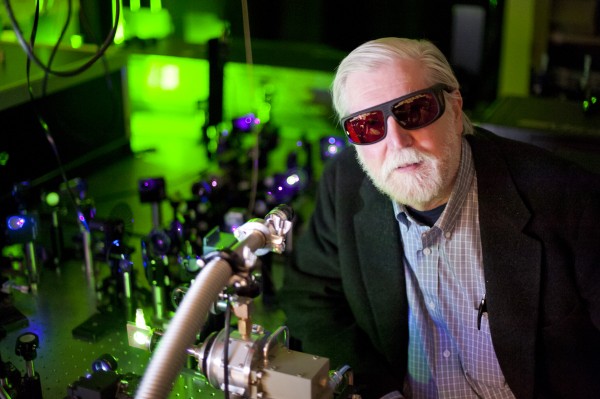Lasers reveal the hidden lives of biomolecules

All around and inside us, an elaborate dance of molecular vibrations is constantly taking place. From the water in your glass to the fluid surrounding your blood cells, molecules exchange energy with their environment. Large molecules, such as the heme group of hemoglobin, can respond with waving, saddling or ruffling motions, said Paul Champion, professor and chair of the Department of Physics. These motions, which can also be excited with a femtosecond laser pulse into so-called “non-stationary coherent states,” are the darlings of his research.
Champion was recently elected as a fellow to the American Association for the Advancement of Science for his “distinguished contributions to the structure and dynamics of biomolecules using novel laser techniques.” These techniques have allowed Champion and his team to probe those non-stationary coherent states in ways never before possible.
“I am delighted that Paul’s pioneering work has been recognized by this honor from AAAS — one of the only scientific societies that embraces the full spectrum of science, with a mission to bring outstanding science to the wider public,” said Murray Gibson, dean of the College of Science.
In the case of the pancake-shaped heme molecule that Champion has spent nearly two decades studying, these low-energy vibrations take place out of the plane, as if someone were setting up vibrations on a drum.
Standard analytical and spectroscopic techniques bombard molecules with optical waves of much higher frequency (or energy), which probe conformations and allow bonds between individual atoms to be identified. The lower energy vibrations that exchange energy with the surroundings are completely hidden from these standard analytical spectroscopic methods.
But these low energy vibrations are necessary for biomolecules to interact with one another and to drive biochemical reactions. For instance, the heme molecule is the body’s primary oxygen transporter. It binds oxygen in hemoglobin, the functional unit of the blood, and acts as a signaling regulator when it binds nitric oxide. “There all kinds of things heme groups do, including important biocatalytic reactions,” said Champion. But we cannot understand how these biomolecular activities so efficiently utilize available thermal energy using standard, commercially available instruments.
So instead, Champion builds his own instruments using special lasers. “You normally think of laser light as having a pure, single frequency with one wavelength,” he explained. “But when you make lasers into short, femtosecond pulses, as the pulses get shorter, the frequency content or bandwidth becomes larger.”
This allows the team to generate wavelengths with differences in their frequencies that are very adept at exciting molecules into those non-stationary, low-energy vibrational states. Essentially, Champion’s lasers allow him to stretch the heme pancake in particular directions, so to speak. He studies the different vibrational states in an effort to understand how they might change when proteins interact with other proteins and how they are involved in pushing reactions over barriers to form products.
“It’s a long-studied, complex and not fully understood subject regarding how elementary particles like electrons and protons are transferred in biological systems,” he said. “We know that they are transferred, but we don’t know how nature has tuned itself up to do it so efficiently and so selectively.”
For example, Champion thinks that there is one type of vibration that helps turn on or off a heme’s ability to give or receive an electron to another protein. This is the type of thing Champion is able to study with his femtosecond pulsed laser beams.
The American Association for the Advancement of Science (AAAS) is the world’s largest general scientific society, serving 10 million individuals. The tradition of AAAS Fellows began in 1874 and honors members for their scientifically or socially distinguished efforts to advance science and its applications.